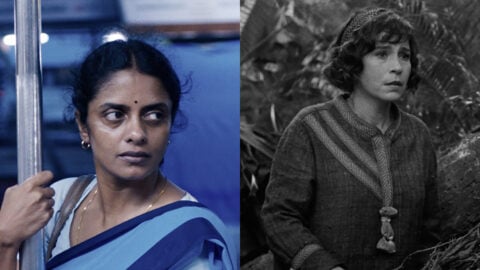Review: Dawn of the Planet of the Apes
The style and vigor of Matt Reeves’s CGI spectacular is demonstrated at approximately the 60-minute mark when an ape brandishing an Uzi, his face contorted in a battle cry recalling Braveheart-era Mel Gibson, gallops through a wall of fire on the back of a black stallion. The scene might call to mind the kind of early-2000s action movie that gave Vin Diesel top billing without any semblance of embarrassment. It’s the “cool guys don’t look back at explosions” joke all over again, except instead of a muscly ex-cop or stunt driver, our wicked warrior is a hairy, teeth-baring ape.

The apes-are-just-like-us conceit has its 46th birthday with Dawn of the Planet of the Apes, the latest entry in a franchise that spans eight movies, two television series, and an array of comic books, novels, and video games. The original 1968 film played out our similarities to our simian cousins in a deadpan critique of human supremacy and creationism—the sort of pessimistic, dialogue-heavy parable out of which its original writer, Rod Serling, made his career. While the ensuing four films became increasingly esoteric and campy, 2011’s surprisingly good Rise of the Planet of the Apes emulated its ancestor’s statement-heavy style in a Frankenstein-esque man-creates-monster origin story. The follow-up takes a step away from that lineage, favoring the explosive fun of a summer blockbuster over cultural critique.
Dawn of the Planet of the Apes begins with a highlight reel of the decade or so that has passed since the previous installment. Excerpts from panicked news reports about CDC quarantines inform us that 99% of the human race has been killed by a virus accidentally created in an experimental Alzheimer’s drug trial in the previous film. The drug’s simian test subjects, however, developed increased intelligence. While the death toll caused civilization to crumble into small colonies of people who are immune to the virus, the able-minded apes who took to the woods have been living free from human contact.

Caesar (Andy Serkis) is the bold, benevolent leader of a community of apes who communicate in a blend of sign language and broken English. A few miles away in the ruins of San Francisco, a group of human survivors, led by a former police chief (an uninvested Gary Oldman), are attempting to live without electricity. Leading the mission to restore power is Malcolm (Jason Clarke) and his wife, Ellie (Keri Russell), an architect-doctor power couple dressed in head-to-toe Patagonia who discover the ape community after a chance encounter on a scouting expedition to an electric dam. As fate would have it, said dam is on ape turf, and though Caesar doesn’t initially trust humans, he and his most devoted followers are willing to cooperate in an attempt to avoid violence. However, his plans are foiled by one of his most trusted comrades, a heavily scarred ape named Koba, who thinks eradicating man is the only way to survive.
Thus begins a two-hour struggle of trust and power between human and ape, the latter of whom begin to break ranks over differing opinions of their new neighbors. But the most memorable moments in Dawn of the Planet of the Apes have little to do with the path of its narrative. Embracing 3-D, the movie looks stunning—from the CGI apes, each individualized with specific micro-facial expressions and scars, to the richly gloomy atmosphere (the overcast skies virtually a calling card now for director Matt Reeves). Every drop of rain and luxuriant display of post-apocalyptic decay oozes a sort of tragic elegance that’s a stark contrast to the well-lit labs of the previous film. The effort put into these aesthetic improvements, however, doesn’t happen without some degradation elsewhere. Or, to quote the two middle-aged fans in matching POTA shirts sitting next to me in the theater: “Something’s just missing.”

While the movie ticks off every mark on the summer blockbuster checklist, the human characters remain noticeably shallow and are consistently overshadowed by their simian CGI counterparts. Little mention is made of the horrible trauma they’ve endured in the pandemic, and with the exception of a scene in which power is momentarily restored and the group hears music for the first time in years, it’s easy to forget that they once lived normal lives. Reeves, who works off a screenplay by Rick Jaffa, Amanda Silver, and Mark Bomback, also seems unsure about his stance on the relationship between the humans and the apes. Throughout the film, the characters repeatedly claim that man’s demise was self-inflicted, a disaster born from the cruelty and selfishness that is intrinsic to human nature. But among the survivors, we see nothing but kindness and dedication to the community.
The original film found its punch line in the way the audience recognizes its own reflection in the actions of the simian villains. Dawn of the Planet of the Apes, on the other hand, aligns us with Caesar and the other human-friendly apes who support peace with mankind. The main human survivors are depicted as such one-dimensional heroes that it’s almost a surprise when Caesar declares, after an act of treachery by Koba, that “ape is just like man.” But unpacking that inconsistency might be like wondering about the mechanics of the cars in The Fast and The Furious: Tokyo Drift. If failing to achieve the quality of double-edged cultural critique of its predecessors, the new film fits snugly within the multiplex—a gun-toting, horseback-riding monkey riding through $170 million flames.







